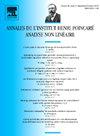Stable singularity formation for the inviscid primitive equations
IF 2.2
1区 数学
Q1 MATHEMATICS, APPLIED
Annales De L Institut Henri Poincare-Analyse Non Lineaire
Pub Date : 2021-12-17
DOI:10.4171/aihpc/87
引用次数: 5
Abstract
The primitive equations (PEs) model large scale dynamics of the oceans and the atmosphere. While it is by now well-known that the three-dimensional viscous PEs is globally well-posed in Sobolev spaces, and that there are solutions to the inviscid PEs (also called the hydrostatic Euler equations) that develop singularities in finite time, the qualitative description of the blowup still remains undiscovered. In this paper, we provide a full description of two blowup mechanisms, for a reduced PDE that is satisfied by a class of particular solutions to the PEs. In the first one a shock forms, and pressure effects are subleading, but in a critical way: they localize the singularity closer and closer to the boundary near the blow-up time (with a logarithmic in time law). This first mechanism involves a smooth blow-up profile and is stable among smooth enough solutions. In the second one the pressure effects are fully negligible; this dynamics involves a two-parameters family of non-smooth profiles, and is stable only by smoother perturbations.无粘原始方程的稳定奇点形成
原始方程(PEs)模拟海洋和大气的大尺度动力学。虽然现在众所周知,三维粘性pe在Sobolev空间中是全局适定的,并且存在在有限时间内发展奇点的无粘性pe(也称为流体静力欧拉方程)的解,但对爆炸的定性描述仍然未被发现。在本文中,我们提供了两个爆破机制的完整描述,对于一个简化的PDE,它是由一类PDE的特解满足的。在第一种情况下,激波形成,压力效应是次要的,但以一种关键的方式:它们使奇点越来越靠近爆炸时间附近的边界(具有对数时间律)。第一种机制涉及平滑的爆破剖面,并且在足够光滑的解中是稳定的。在第二种情况下,压力的影响完全可以忽略不计;这种动力学涉及一个双参数的非光滑轮廓族,并且只有在更光滑的扰动下才稳定。
本文章由计算机程序翻译,如有差异,请以英文原文为准。
求助全文
约1分钟内获得全文
求助全文
来源期刊
CiteScore
4.10
自引率
5.30%
发文量
62
审稿时长
>12 weeks
期刊介绍:
The Nonlinear Analysis section of the Annales de l''Institut Henri Poincaré is an international journal created in 1983 which publishes original and high quality research articles. It concentrates on all domains concerned with nonlinear analysis, specially applicable to PDE, mechanics, physics, economy, without overlooking the numerical aspects.

 求助内容:
求助内容: 应助结果提醒方式:
应助结果提醒方式:


